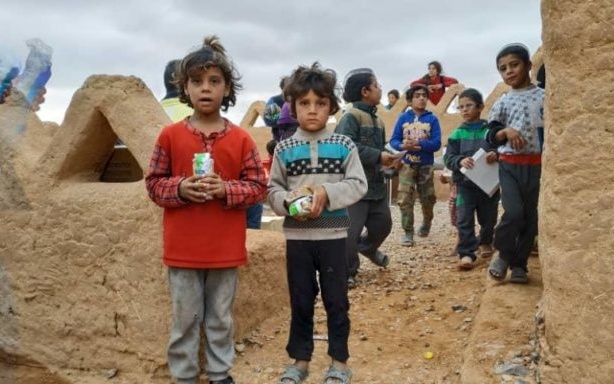Children among 13,000 displaced persons in the Rukban camp, southeast Syria (UNHCR)
The 13,000 displaced civilians in Syria’s Rukban camp — having withstood deprivation, a Russian-Assad regime siege and coercion, and US inaction for more than five years — may soon get a doctor.
Then again, the signals are that they will not.
In 2015, residents of Homs Province in central Syria fled amid Islamic State attacks. They wound up in the barren area in southeastern Syria, near the Jordanian border.
At one time, there were about 75,000 civilians in the camp. But Jordan closed the border in June 2016 after a suicide bombing killed several border guards. The restriction of food and supplies was further tightened in September 2018 when Russian and regime forces cut the main road into the camp.
Moscow and the regime pressured civilians to return to Homs Province, through propaganda about “terrorists” backed by the US and the threats of starvation, poor conditions, contaminated water and lack of medical care. The last doctors left the camp, leaving nurses in a rudimentary clinic.
Despite the deprivation, about 13,000 residents have refused to be transferred. They express fear of regime harassment, detention, and even disappearance and killing.
Now Dr. Zaher Sahloul, the President of the US-based Medglobal, is hoping to establish a clinic in Jordan, just across the border from Rukban. There is an existing UN medical point, evacuated in March amid fears of Coronavirus.
But Medglobal will need the permission of Amman’s authorities for the camp’s residents to make the crossing for essential medical care. Jordan has refused the delivery of aid since 2018, with Foreign Minister of Jordan Ayman Safadi saying it is “a responsibility that must be shouldered by Syria and the international community”.
And any doctor who enters Rukban will need de facto acceptance by Russia and the regime, as well as authorization from the US military — the camp is in an 55-km (34-mile) security zone around the American base at al-Tanf on the Iraq border.
As Sahloul is a US citizen, he could be escorted by American personnel. But the US military has been reluctant to test the Russia-regime siege, concerned that it might lead to conflict with the Russians. There have been rare exceptions, such as the move in April of two pregnant women to the al-Tanf base for emergency Caesarean sections.
On October 30, the outgoing US special envoy for Syria, James Jeffrey, told Syria Direct that State Department was “aware” of Medglobal’s initiative and “is looking into it”.
But he immediately distanced Washington from the effort, saying that the Assad regime must provide for the camp and the US Government “is not going to take on responsibility for the long-term humanitarian care”.
Sahloul explained to Syria Direct’s Will Christou that the Rubkan residents are suffering from “chronic diseases, asthma and other respiratory diseases, in addition to a lack of reproductive and maternal healthcare”. There have been deaths from malnutrition and of women in childbirth.
See Syria Daily, Oct. 6, 2018: Trapped — The Pregnant Women in the Rukban Camp
There was a limited success this summer with the supply of a water purification project to clear up skin diseases among children. Costing $2,000, the project provided two weeks worth of purified water to more than 1,000 families.
Simona Jeger, a pharmacist who coordinated and funded the project, told Christou, “Imagine what could happen if a government gave just $10,000 a month to the camp.”
In July, a new surgical clinic was constructed. However, with no surgeon, there have been no operations to date.

